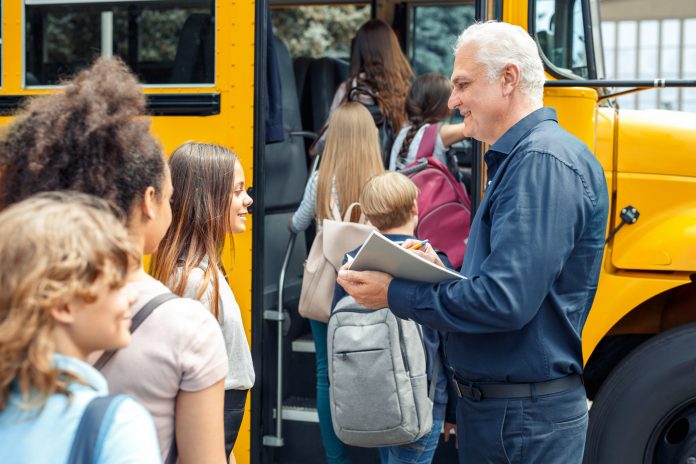The new coronavirus has reignited a somewhat controversial concept of tracking student assets on school transportation vehicles.
Several years ago, technology evolved to issue students an electronic card to scan when they board and deboard a school bus. This concept was not met with open arms in every state. Some were concerned with data privacy, high costs to implement and maintain and for some it was the further eroding of their constitutional rights. Opinions on the other end of the spectrum were happy to have a system that allowed schools systems and parents a way to adequately verify a child’s location or ridership for that particular day, should a situation arise in which a student could not be found, usually momentarily.
Fast forward to spring 2020, the new coronavirus has closed most schools across America, and the ideology has evolved from tracking to tracing. Health experts and educational planners alike share the desire to be able to trace who students have been in contact with during their educational day. This would allow school administrators, the thinking goes, to prevent potential exposure, if new cases are found within a school system.
As the stay-at-home orders are beginning to be lifted in various states, we know that coming back to a “normal” school startup is not likely. Many school systems are planning for alternate schedules, social distancing requirements, and the need to better identify where a student is during each part of their academic day. This begins with the bus in the morning, extends to their time spent in a building or buildings, and ends with possibly riding a shuttle to and from another location, and then a ride home.
How transportation professionals can help prepare to support the school’s system they serve requires a different perspective, potential changes in processes and procedures, and accelerated implementation of technology that can adequately aid in the efforts of tracing a student’s day.
The following is a brief “nuts and bolts” narrative of a few key areas of preparation for student tracking and tracing.
- Create a transportation registration system in coordination with your organization’s technology department, building administrators and building support staff representatives (administrative assistants). Parents can register eligible students to ride the bus during the enrollment process each spring or summer for the following school year.
- Utilize this data to create rosters of students that are assigned to ride each bus run in your system. This includes inter-school shuttles. Enter those into your routing program or paper rosters/manifests for each run and route.
- Research and procure a GPS tracking system for your fleet. Perform a S.W.O.T. (Strengths, Weaknesses, Opportunities, Threats) analysis on each product and really dive into the ability to communicate to other school systems. Always be careful when purchasing software to try to align it with current and future software needs. Also, make sure that the end result the system needs is what the program will completely provide you with, without modifications or additional support.
- Research and procure student tracking software and appropriate processes and procedures for initial implementation and ongoing maintenance.
- Develop training for all users: staff, parents, students.
- Serve as a conduit for communication and engagement of stakeholders. Utilize multiple methods and multiple venues, including social networking sites, the local media, email campaigns, and phone trees.
- Secure funds for these items as an investment in student safety.
This may seem overwhelming. You are correct. And you need a roadmap.
Even those who have some of these processes and systems already in place will need help implementing these changes into the overall larger complex organization. It is okay if you don’t have all the answers, sharing basic “nuts and bolts” of how to get there will start the conversation. It is also okay to engage professionals to help implement these programs into your organization, especially in a short timeframe.
A good rule of thumb to remember when maneuvering something new and different is that everyone else is experiencing it along with you. It is okay to not have all the answers. Being the voice that can help facilitate a solution and create a roadmap is oftentimes what leaders are looking to transportation professionals for.
I would encourage you to be the voice of advocacy for student safety and welfare from the transportation department lens. These “nuts and bolts” are just a start to the larger conversation, and much time and consideration will be needed to define a process and subsequent procedures for a successful implementation. The normal we are all looking for will have some components of student tracing in it when school begins again. How that rolls out in your transportation organization and then the larger school system can begin with you.
Be a part of the conversation from the beginning with school leadership, get yourself a seat at the table to be heard and collaborate.
Listen to Episode 6 of the School Transportation Nation podcast, featuring Ryan Hahn.
 Ryan Hahn is a former director of transportation and has nearly 20 years of experience in the school transportation industry, starting his career as a school bus driver. He is currently a consultant to transportation departments on routing, management and communications. He may be reached at ryan.hahn@strategicschoolconsultants.com.
Ryan Hahn is a former director of transportation and has nearly 20 years of experience in the school transportation industry, starting his career as a school bus driver. He is currently a consultant to transportation departments on routing, management and communications. He may be reached at ryan.hahn@strategicschoolconsultants.com.
















